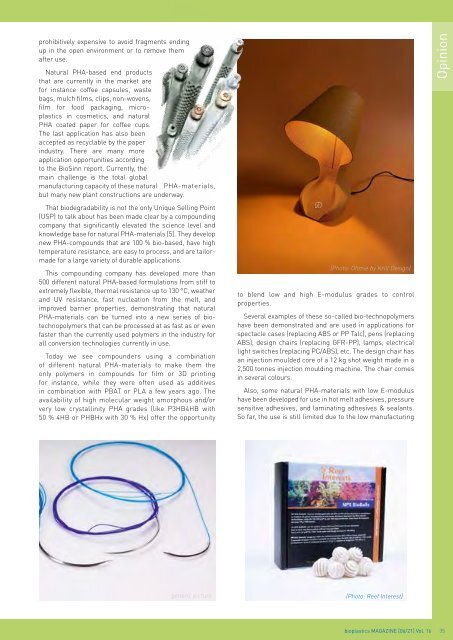Issue 06/2021
Highlights: Coating Films, Flexibles, Bags Basics: Cellulose based bioplastics
Highlights:
Coating
Films, Flexibles, Bags
Basics: Cellulose based bioplastics
You also want an ePaper? Increase the reach of your titles
YUMPU automatically turns print PDFs into web optimized ePapers that Google loves.
prohibitively expensive to avoid fragments ending<br />
up in the open environment or to remove them<br />
after use.<br />
Natural PHA-based end products<br />
that are currently in the market are<br />
for instance coffee capsules, waste<br />
bags, mulch films, clips, non-wovens,<br />
film for food packaging, microplastics<br />
in cosmetics, and natural<br />
PHA coated paper for coffee cups.<br />
The last application has also been<br />
accepted as recyclable by the paper<br />
industry. There are many more<br />
application opportunities according<br />
to the BioSinn report. Currently, the<br />
main challenge is the total global<br />
manufacturing capacity of these natural PHA-materials,<br />
but many new plant constructions are underway.<br />
(Photo: Prodir)<br />
That biodegradability is not the only Unique Selling Point<br />
(USP) to talk about has been made clear by a compounding<br />
company that significantly elevated the science level and<br />
knowledge base for natural PHA-materials [5]. They develop<br />
new PHA-compounds that are 100 % bio-based, have high<br />
temperature resistance, are easy to process, and are tailormade<br />
for a large variety of durable applications.<br />
This compounding company has developed more than<br />
500 different natural PHA-based formulations from stiff to<br />
extremely flexible, thermal resistance up to 130 °C, weather<br />
and UV resistance, fast nucleation from the melt, and<br />
improved barrier properties, demonstrating that natural<br />
PHA-materials can be turned into a new series of biotechnopolymers<br />
that can be processed at as fast as or even<br />
faster than the currently used polymers in the industry for<br />
all conversion technologies currently in use.<br />
Today we see compounders using a combination<br />
of different natural PHA-materials to make them the<br />
only polymers in compounds for film or 3D printing<br />
for instance, while they were often used as additives<br />
in combination with PBAT or PLA a few years ago. The<br />
availability of high molecular weight amorphous and/or<br />
very low crystallinity PHA grades (like P3HB4HB with<br />
50 % 4HB or PHBHx with 30 % Hx) offer the opportunity<br />
(Photo: Ohmie by Krill Design)<br />
to blend low and high E-modulus grades to control<br />
properties.<br />
Several examples of these so-called bio-technopolymers<br />
have been demonstrated and are used in applications for<br />
spectacle cases (replacing ABS or PP Talc), pens (replacing<br />
ABS), design chairs (replacing GFR-PP), lamps, electrical<br />
light switches (replacing PC/ABS), etc. The design chair has<br />
an injection moulded core of a 12 kg shot weight made in a<br />
2,500 tonnes injection moulding machine. The chair comes<br />
in several colours.<br />
Also, some natural PHA-materials with low E-modulus<br />
have been developed for use in hot melt adhesives, pressure<br />
sensitive adhesives, and laminating adhesives & sealants.<br />
So far, the use is still limited due to the low manufacturing<br />
Opinion<br />
generic picture<br />
(Photo: Reef Interest)<br />
bioplastics MAGAZINE [<strong>06</strong>/21] Vol. 16 35

















